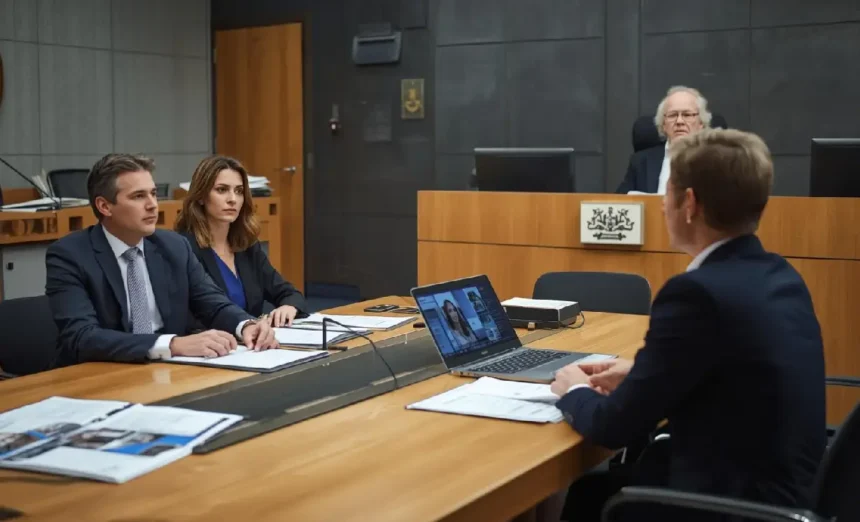Many Australians find themselves preparing for a tribunal hearing, whether it’s for a small claim, tenancy dispute, or consumer complaint. The outcome often hinges on one critical factor: the strength and organization of your evidence for a tribunal case in Australia.
- What Is a Tribunal Case in Australia?
- Types of Evidence You Can Use in a Tribunal
- How to Organize and Present Your Evidence
- What Tribunal Members Look for in Evidence
- What Happens If You Don’t Have Enough Evidence?
- Tips for the Day of Your Hearing
- Conclusion
- FAQs
- What counts as strong evidence in an Australian tribunal?
- Can I win a tribunal case in Australia without written evidence?
- Do I need to bring original documents to my tribunal hearing?
- Are text messages valid evidence in NCAT or other tribunals?
- How do I label my evidence for a tribunal hearing?
- What’s the burden of proof in Australian tribunal cases?
- Can I bring a witness to an Australian tribunal?
- What happens if the other party doesn’t bring evidence?
- Are tribunal hearings in Australia recorded?
- Can I submit my evidence online before the hearing?
Unlike formal court proceedings, tribunals offer a more accessible path to justice. However, this informality doesn’t mean you can arrive unprepared. Tribunal members make decisions based on the evidence presented, and knowing what to bring—and how to present it—can mean the difference between success and disappointment.
In this guide, we’ll walk you through the types of evidence tribunals accept, how to organize it effectively, and what decision-makers actually look for when reviewing your case. Whether you’re heading to NCAT, VCAT, or another state tribunal, these practical insights will help you prepare with confidence.
What Is a Tribunal Case in Australia?
Tribunals are specialist decision-making bodies that resolve disputes outside the traditional court system. They handle matters ranging from tenancy disagreements to consumer complaints, with procedures designed to be less formal and more accessible than courts.
When you lodge a tribunal application, you’re essentially asking an independent member to review the facts and make a binding decision. The evidence you provide forms the foundation of this decision-making process, which is why preparation matters so much.
Common Tribunal Types
Australia has several state-based tribunals that handle civil and administrative disputes:
- NCAT (NSW Civil and Administrative Tribunal) – handles tenancy, consumer claims, and administrative reviews
- VCAT (Victorian Civil and Administrative Tribunal) – covers similar matters in Victoria
- QCAT (Queensland Civil and Administrative Tribunal) – Queensland’s equivalent
- SACAT (South Australian Civil and Administrative Tribunal) – serves South Australian residents
In 2022–23, NCAT alone received over 67,000 applications, with tenancy and consumer disputes representing the most common case types. Understanding your specific tribunal’s rules is essential for proper evidence preparation.
How Tribunal Cases Differ from Court
Tribunals operate with less formality than traditional courts, making them more approachable for self-represented parties. Key differences include:
- Lower filing fees – typically $50–$200 compared to court costs
- Relaxed evidence rules – strict court procedures don’t always apply
- No wigs or robes – members wear business attire
- Active questioning – tribunal members often ask questions directly
- Faster resolution – hearings usually occur within weeks or months
Despite this informality, tribunals still require credible, relevant evidence. The [small claims process](small claims process) shares many similarities with tribunal proceedings, both emphasizing accessible justice for everyday Australians.
Types of Evidence You Can Use in a Tribunal
Understanding what constitutes acceptable evidence is your first step toward building a winning case. Australian tribunals accept various evidence types, each serving different purposes in supporting your claim.
1. Documentary Evidence
Written documents form the backbone of most tribunal cases. These include:
- Contracts and agreements
- Invoices, receipts, and payment records
- Letters, emails, and text messages
- Bank statements showing transactions
- Photographs with timestamps
- Professional reports or assessments
Documentary evidence carries significant weight because it provides objective proof of events, agreements, or conditions. For example, a signed lease agreement clearly establishes the terms of a tenancy, while dated invoices demonstrate payment obligations.
When gathering documents, ensure they’re complete and legible. A partially visible receipt or cropped email may not serve your purpose effectively.
2. Photographic or Video Evidence
Visual evidence can be particularly powerful in disputes involving property damage, product defects, or condition assessments. Modern smartphones make capturing evidence straightforward, but quality matters.
Best practices for visual evidence:
- Include timestamps when possible
- Take multiple angles of the same issue
- Ensure adequate lighting
- Capture context (not just close-ups)
- Store originals securely
A tenant recently provided timestamped photos and dated emails to prove mould damage was ignored by their landlord—resulting in a favourable NCAT decision. The visual evidence, combined with correspondence showing the landlord was notified, created an irrefutable timeline.
3. Witness Statements or Testimony
Sometimes you need another person to corroborate your version of events. Witnesses can provide statements or, in some cases, attend the hearing in person.
For tribunal purposes, written [statutory declaration evidence](statutory declaration evidence) often suffices. These are formal statements made under oath, carrying legal weight. Your witness should:
- State their relationship to you
- Describe only what they directly observed
- Include specific dates and details
- Sign before an authorized witness (JP, lawyer, etc.)
Keep in mind that tribunal members may question the credibility of witnesses who have personal relationships with you, so their testimony should align with documentary evidence where possible.
Understanding your [tenant rights evidence](tenant rights evidence) requirements becomes particularly important when preparing witness statements for tenancy disputes.
Evidence Type Comparison
| Evidence Type | Best Used For | Strength |
|---|---|---|
| Documents | Proving agreements, payments, and correspondence | Very High |
| Photos/Video | Showing condition, damage, and physical evidence | High |
| Witness Statements | Corroborating events, providing context | Medium-High |
| Your Own Testimony | Explaining circumstances, connecting evidence | Medium |
How to Organize and Present Your Evidence
Having strong evidence means nothing if you can’t present it clearly. Tribunal members review numerous cases daily, so organised, easy-to-follow evidence makes their job easier—and improves your chances of success.
1. Label and Chronologize
Create a logical system for your evidence:
- Number each document (Exhibit 1, Exhibit 2, etc.)
- Arrange chronologically where possible
- Use clear, descriptive labels
- Create a separate exhibit for different evidence types
For example, if you’re presenting a consumer dispute about faulty goods, your exhibits might flow: Purchase receipt (Exhibit 1) → Photos of defect (Exhibit 2) → Complaint email to seller (Exhibit 3) → Response or lack thereof (Exhibit 4).
This logical progression tells your story through evidence, making it easier for the tribunal member to follow your narrative.
2. Create an Evidence List
Many tribunals recommend or require an evidence list—a document that outlines every exhibit you’re submitting. This typically includes:
- Exhibit number
- Brief description
- Date of document
- Number of pages
Some tribunals have specific templates available on their websites. Check your tribunal’s practice notes or guidelines before your hearing date.
3. Use Copies and Keep Originals
Practical submission tips:
- Bring at least three copies of everything (one for you, one for the member, one for the other party)
- Keep original documents safe—submit copies unless specifically requested
- For electronic hearings, have files clearly named and ready to share
- Consider a USB backup if technology fails
VCAT specifically recommends bringing three printed copies of key documents to ensure smooth proceedings. Even in our digital age, having physical backup proves invaluable when technology doesn’t cooperate.
Proper preparation aligns with general guidance on how to [prepare for tribunal](prepare for tribunal) effectively, ensuring you’re ready for any format or circumstance.
Evidence Preparation Checklist
- All documents copied (3 sets minimum)
- Exhibits are numbered and labelled
- Evidence list prepared
- Chronological order checked
- Originals secured separately
- Digital backup created
- All files clearly named
What Tribunal Members Look for in Evidence
Understanding the decision-maker’s perspective helps you present evidence strategically. Tribunal members assess evidence through specific criteria that determine its usefulness and persuasiveness.
Relevance and Reliability
Every piece of evidence should directly support your claim. Irrelevant documents, regardless of how official they look, won’t help your case—and may actually distract from your key points.
Reliability concerns the trustworthiness of your evidence. Tribunal members consider:
- Is the document authentic?
- Does it come from a credible source?
- Has it been tampered with or altered?
- Does it directly address the dispute?
NCAT’s Member’s Guide to Evidence emphasizes that evidence should be concise and directly address the issue in dispute. Overwhelming the tribunal with marginally relevant documents can actually weaken your case by obscuring the crucial facts.
Each state tribunal publishes evidence guidelines. Familiarising yourself with these before your hearing demonstrates preparedness and respect for the process.
Consistency with Your Story
Your evidence must align with the facts stated in your application and any subsequent submissions. Contradictions between your written claims and presented evidence undermine credibility.
Suppose you stated in your application that a repair request was made in March, but your evidence shows it was actually April. In that case, this inconsistency may cause the tribunal member to question other aspects of your case.
Before your hearing, review your application alongside your evidence to ensure everything aligns. If you discover an error, address it proactively rather than hoping it goes unnoticed.
Brevity and Clarity
More isn’t always better. Tribunal members appreciate evidence that’s:
- Clearly labelled and easy to navigate
- Limited to relevant materials
- Accompanied by brief explanations when needed
- Free from unnecessary background or commentary
One applicant submitted a 200-page bundle for a straightforward consumer dispute. The tribunal member spent valuable hearing time searching for relevant documents, ultimately commenting that the excessive volume made the case harder to assess.
“Evidence should be concise, relevant, and directly address the matters in dispute. Quality always trumps quantity in tribunal proceedings.” — NCAT Member’s Guide to Evidence (2023)
Understanding [why claims fail](why claims fail) often reveals that poor evidence presentation—not weak facts—caused the unfavourable outcome. Clear, focused evidence paired with a strong [tribunal statement clarity](tribunal statement clarity) gives you the best chance of success.
What Happens If You Don’t Have Enough Evidence?
Sometimes, circumstances prevent you from gathering ideal documentation. Perhaps the other party didn’t provide written agreements, or records were lost over time. Understanding your options helps you make the best of a challenging situation.
Burden of Proof in Tribunals
Australian tribunals use the civil standard of proof: “balance of probabilities.” This means you must show it’s more likely than not that your version of events occurred.
Unlike criminal cases requiring proof “beyond a reasonable doubt,” civil tribunals only need to be satisfied that your account is more probable than the alternative. This lower threshold means that even without perfect evidence, a consistent, credible case can succeed.
However, the burden falls on you as the applicant. If evidence is equally balanced—or worse, favours the other party—your claim will likely fail.
Using Stat Decs or Affidavits in Absence of Documents
When documentary evidence doesn’t exist, statutory declarations or affidavits become crucial. These sworn statements can:
- Describe verbal agreements
- Explain the circumstances of lost documents
- Provide first-hand accounts of events
- Establish timelines and sequences
However, remember that your own statement alone rarely suffices. Tribunal members are aware that parties have an incentive to present facts in a favorable light. Supporting evidence—even if circumstantial—strengthens sworn statements significantly.
A consumer claim at QCAT was dismissed despite the applicant believing the respondent was at fault. The lack of any documentary proof—no emails, no receipts, no photos—meant the tribunal couldn’t determine who was telling the truth. The case hinged entirely on competing verbal accounts with nothing to corroborate either version.
Understanding the [burden of proof](burden of proof) and knowing [how to write an affidavit](using affidavits) properly can help bridge evidence gaps when documents aren’t available.
FAQ: Can I still win without written evidence?
Yes, but it’s significantly harder. Strong witness testimony, logical consistency, and circumstantial evidence can support your case. However, written documentation dramatically increases your chances of success. If documents exist, make every effort to obtain them before your hearing date.
Tips for the Day of Your Hearing
Preparation continues right through to the hearing itself. How you present evidence during proceedings can be as important as the evidence itself.
Bring Hard Copies & Digital Backup
Technology failures happen. Internet connections drop. Files won’t open. Laptops crash. Protect yourself by having multiple formats available:
- Printed copies (preferably in a ring binder for easy reference)
- Digital files on your device
- USB backup with clearly labelled folders
- Cloud storage access (if internet available)
At VCAT, one applicant’s laptop failed to connect to the tribunal’s display system. Because they had printed copies ready, the hearing continued without delay. Always assume technology will fail and prepare accordingly.
Know How to Refer to Exhibits
Practice referencing your evidence before the hearing. You’ll need to direct the tribunal member to specific documents efficiently:
- “I refer to Exhibit 3, which is the email dated 15 March…”
- “The photographic evidence in Exhibit 7 shows…”
- “If you turn to Exhibit 1, the signed agreement, you’ll see…”
This professional approach keeps proceedings moving smoothly and demonstrates you’ve prepared thoroughly. Fumbling through unorganized papers creates a negative impression and wastes valuable hearing time.
Stay Calm and Organized
Hearings can feel stressful, especially if you’re self-represented. Remember:
- The tribunal member wants to understand the facts, not catch you out
- It’s acceptable to take a moment to find documents
- You can ask for clarification if you don’t understand a question
- Respectful, clear communication matters more than legal jargon
At NCAT, applicants are often asked to walk through their evidence in order. Knowing your documents intimately—what each exhibit contains and why it’s relevant—makes a strong impression and helps you respond confidently to questions.
Following general [self-representation tips](self-representation tips) and reviewing the complete [tribunal hearing checklist](tribunal hearing checklist) ensures you’re ready for every aspect of the hearing day.
Hearing Day Preparation Steps
- Arrive 15 minutes early
- Have evidence bundles ready (3 copies)
- Know your exhibit numbers and contents
- Prepare a brief opening statement
- Have notes on key points (but don’t read verbatim)
- Bring water and any necessary medications
- Turn off mobile phone before entering
- Be respectful to all parties and tribunal staff
Conclusion
Bringing the right evidence—and presenting it clearly—can make or break your tribunal case in Australia. From tenancy disputes to small claims, tribunals rely heavily on documentary proof, visual evidence, and credible testimony to make fair decisions.
Success comes from understanding what evidence you need, organising it logically, and presenting it confidently. Remember that tribunal members deal with dozens of cases, so clear, relevant, and well-organised evidence helps them understand your position quickly and accurately.
If you’re still unsure about your preparation, explore our related guides on understanding the [NCAT hearing process](NCAT hearing process), learning how the broader [small claims process](small claims process) works, and discovering effective strategies for presenting your case.
What’s your biggest concern about gathering evidence for your tribunal case? Share your questions in the comments below, and let’s help each other navigate the tribunal system successfully.
FAQs
What counts as strong evidence in an Australian tribunal?
Strong evidence includes signed contracts, receipts, emails, photographs, and witness statements that directly support your claim. It should be relevant, dated, and clearly linked to the issue in dispute.
Can I win a tribunal case in Australia without written evidence?
It’s possible, but difficult. Tribunals rely heavily on written proof. Verbal statements or statutory declarations may help, but written evidence is more persuasive.
Do I need to bring original documents to my tribunal hearing?
Yes, bring original documents if possible, along with at least two copies — one for the tribunal member and one for the other party. Some tribunals accept digital versions too.
Are text messages valid evidence in NCAT or other tribunals?
Yes, text messages can be used as evidence if they are relevant and show communication between the parties. Make sure to include dates and screenshots.
How do I label my evidence for a tribunal hearing?
Use clear labels like “Exhibit A”, “Attachment 1”, and organise them in chronological order. Also prepare a list of all your exhibits to help the tribunal follow your case.
What’s the burden of proof in Australian tribunal cases?
In most tribunal cases, you must prove your case on the balance of probabilities, meaning your version of events is more likely to be true than not.
Can I bring a witness to an Australian tribunal?
Yes, you can bring a witness or submit a written statement from them. A statutory declaration is often accepted if the witness can’t attend.
What happens if the other party doesn’t bring evidence?
If the other party fails to bring evidence, the tribunal may decide in your favour — but only if your evidence is strong and clearly supports your case.
Are tribunal hearings in Australia recorded?
Some tribunals record hearings, but not all. You can usually request access to recordings or transcripts, depending on the tribunal’s rules.
Can I submit my evidence online before the hearing?
Many tribunals like NCAT and QCAT allow you to upload evidence online before your hearing. Always check the specific rules for your state or territory tribunal.






